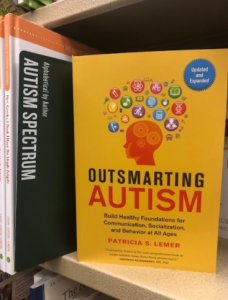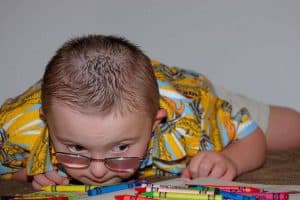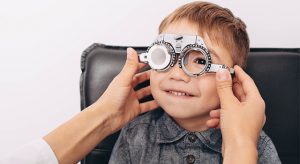Down syndrome (DS) is the most common genetic disorder, affecting 1 in every 800 births (National Down Syndrome Society).
How does Down syndrome affect a child’s ability to learn, and how can parents and teachers help make life just a little bit easier on these children?
Here are our top 6 frequently asked questions about Down syndrome, vision issues and how parents and teachers can help:
Q1: What is Down syndrome?
Down syndrome is a condition in which a child is born with an extra copy of their 21st chromosome, causing physical and mental developmental delays and disabilities.
Many of the disabilities are lifelong, including problems with vision, such as increased risk of refractive error, impaired visual processing and binocular vision issues.
Fortunately, advances in medicine, as well as cultural and societal supports have made life for those who live with Down syndrome and their families easier than ever before.
Though challenges still exist, it is quite possible for those with Down syndrome to live a long, fulfilling and interesting life.
Q2: How common are refractive errors in people with Down syndrome?
Research published in Clinical and Experimental Optometry (January, 2015), shows that between 50% and 80% of children with Down syndrome deal with refractive errors.
These errors can harm their ability to learn in the classroom, and tend to increase throughout the child’s school-age years.
Refractive error refers to vision issues caused by the eye being either too long or too short, or by problems with the cornea or lens of the eye.
These problems cause light entering the eye to become blurry as it reaches the retina at the back of the eye, either because the light is focused too far forward in the eye or too far back in the eye. Depending on the cause of the error, vision blur may happen close-up, far away or both.
Common refractive errors include hyperopia (farsightedness) astigmatism (blurring of vision at all distances) and myopia (nearsightedness).
SEE RELATED: Vision and Down Syndrome
For more information about how Down syndrome can affect vision and how parents and teachers can make life easier on children with Down syndrome, contact your eye doctor.
Q3: What visual issues are common in people with Down syndrome?
Down syndrome can cause issues with impaired processing in the optic nerves and visual cortex. This may harm visual acuity in children with Down syndrome, causing problems with vision skills such as visual focusing and contrast sensitivity.
Visual focusing refers to the eyes’ ability to alter lens shape efficiently and accurately to maintain focus when shifting between near and far vision.
Problems with visual accommodation can cause blurry/double vision each time the child has to change what they’re looking at. This can affect a child in many ways, for instance, visual accommodation is important for taking notes in class, as a child switches between looking at the board that may be a few yards away, to the notebook on their desk, only a foot or two away.
The constant need to focus and refocus vision each time a child switches what they are looking at can cause headaches and eye strain, along with frustration because of visual discomfort.
According to a study in Investigative Ophthalmology & Visual Science (May, 2004), all children living with Down syndrome deal with this issue to some extent.
Contrast sensitivity refers to a child’s ability to tell objects and images apart from their background, even when there is very little contrast between the two.
Down syndrome often causes difficulty with this, making activities such as reading and writing very difficult.
Q4: Are people with down syndrome more likely to experience binocular vision problems?
Yes.
Binocular vision refers to the eyes’ ability to work in unison to collect and send visual information to the brain to be interpreted and combined into a single three-dimensional image. This process also allows a person to have a sense of depth and distance.
People with Down syndrome are significantly more likely to experience conditions that hinder the process of binocular vision, such as strabismus (eye turn) and lazy eyes.
These conditions can cause problems with three-dimensional vision and depth perception, double or blurry vision, eye strain and headaches.
Q5: Does Down syndrome increase risk of eye disease?
Yes.
According to a report in Clinical and Experimental Optometry (January 2015), up to 2% of babies with Down syndrome will have cataracts in infancy.
Down syndrome causes the eye to develop irregularly, increasing the risk of problems with the formation of the cornea. This can cause the development of a condition known as keratoconus, in which the cornea takes on a conical shape, creating severe blurring and visual distortion.
This is why it’s important to ensure a baby with Down syndrome has regular eye care from the beginning of their life. Early detection and treatment is the best way to ensure their eye health and good vision.
Q6: How can parents and teachers help their child with Down syndrome deal with vision issues?
Recommendations for how parents and teachers can help make life easier for children who have Down syndrome and vision issues include:
1. Accommodations in the classroom and at home
Focusing difficulties means the child may find it more challenging to sit far away from the board, sitting closer to the teacher will help.
Using larger fonts when writing and using visual prompts such as photographs and drawings, can help these children immensely.
2. Correct eyeglasses
Many studies have been conducted on the effectiveness of early prescription of eyeglasses for children with Down syndrome.
Prescription of eyeglasses helps improve learning, encourage healthy vision development and prevent vision symptoms that can cause discomfort and frustration.
Eyeglasses can be single vision prescriptions. or bifocal/multifocal lenses, to correct for accommodative issues such as convergence insufficiency.
3. Frequent eye exams
Children with Down syndrome should have a comprehensive eye exam every six months. This is due to the high potential for vision-threatening eye diseases and eye issues that can severely affect learning and every-day function.
LEARN MORE: Vision for Special Needs
If you have a child with Down syndrome, contact an eye doctor near you to schedule a comprehensive eye exam.
How does Down syndrome affect a child’s ability to learn, and how can parents and teachers help make life just a little bit easier on these children?
Here are our top 6 frequently asked questions about Down syndrome, vision issues and how parents and teachers can help.









